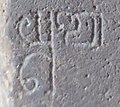Yūpa
A Yūpa (यूप), or Yūpastambha, was a
The execution of a victim (generally an animal), who was tied at the yūpa, was meant to bring prosperity to everyone.[1][2]
Most yūpa, and all from the Vedic period, were in wood, and have not survived. The few stone survivals seem to be a later type of memorial using the form of the wooden originals. The Isapur Yupa, the most complete, replicates in stone the rope used to tether the animal. The topmost section is missing; texts describe a "wheel-like headpiece made of perishable material", representing the sun, but the appearance of that is rather unclear from the
Isapur Yūpa
The Isapur Yūpa, now in the
-
Vāsishka inscription on the Isapur Yūpa.
-
Translation of the inscription mentioning the usage of the sacrificial pillar.
-
Isapur Yūpa with sculpture of a rope and noose to be tied to the sacrificial animal.[6]
Yūpa in coinage
During the Gupta Empire period, the Ashvamedha scene of a horse tied to a yūpa sacrificial post appears on the coinage of Samudragupta. On the reverse, the queen is holding a chowrie for the fanning of the horse and a needle-like pointed instrument, with legend "One powerful enough to perform the Ashvamedha sacrifice".[7][8]
-
Samudragupta coin with horse standing in front of a yūpa sacrificial post, with legend "The King of Kings, who had performed the Ashvamedha sacrifice, wins heaven after conquering the earth".[7][8]
-
Another version of the Ashvamedha scene. Coinage of Samudragutpa.
Yūpa inscription in Indonesia
The oldest known Sanskrit inscriptions in the
In addition to Mulavarman, the reigning king, the inscriptions mention the names of his father Aswawarman and his grandfather Kudungga (the founder of the Kutai Martadipura Kingdom). Aswawarman is the first of the line to bear a Sanskrit name in the Yupa which indicates that he was probably the first to adhere to Hinduism.[10]
-
One of the yūpaNational Museumin Jakarta
-
Mulavarman inscription on a yūpa, 5th century CE
-
Mulavarman inscription on a yūpa, 5th century CE
-
The word "Yūpo" in Brahmi in a Mulavarman Inscription, Muara Kaman, Kalimantan, 5th century CE
Text
The four Yupa inscriptions founded are classified as "Muarakaman"s and has been translated by language experts as follows:
|
Muarakaman I[11]
|
Muarakaman II[12]
|
Muarakaman III[12]
|
Muarakaman IV[13]
|
Translation
Translation according to the Indonesia University of Education:[14]
|
Muarakaman I |
Muarakaman II |
Muarakaman III |
Muarakaman IV |
The Yupas are now kept in the
References
- ^ ISBN 978-0-226-06456-7.
- ^ JSTOR 42930469.
- ^ Irwin, John, "The Heliodorus Pillar: A Fresh Appraisal", p. 8, AARP, Art and Archaeology Research Papers, December, 1974, Internet archive, (also published in Purātattva, 8, 1975-1976, pp. 166-178)
- ^ Catalogue Of The Archaeological Museum At Mathura. 1910. p. 189.
- ^ Rosenfield, John M. (1967). The Dynastic Arts of the Kushans. University of California Press. p. 57.
- ISBN 978-81-317-1677-9.
- ^ ISBN 978-90-04-11344-2.
- ^ ISBN 978-0-391-03250-7.
- ^ Kulke, Hermann (1998). A History of India. p. 145.
- ^ a b S. Supomo, "Chapter 15. Indic Transformation: The Sanskritization of Jawa and the Javanization of the Bharata" in Peter S. Bellwood, James J. Fox, Darrell T. Tryon (eds.), The Austronesians: Historical and Comparative Perspectives, Australian National University, 1995
- ^ R.M. Poerbatjaraka, Riwayat Indonesia, I, 1952, hal. 9.
- ^ a b R. M. Poerbatjaraka, Ibid., hal. 10.
- ^ R. M. Poerbatjaraka, Ibid., hal. 11.
- ^ Sumantri, Yeni Kurniawati. Rangkuman Materi Perkuliahan: Sejarah Indonesia Kuno. Fakultas Pendidikan Ilmu Pengetahuan Sosial, Universitas Pendidikan Indonesia.
- ^ Note: archaeologists and historical experts has stated that "Waprakeswara" referred to a field dedicated to worship the Lord Shiva




![Isapur Yūpa with sculpture of a rope and noose to be tied to the sacrificial animal.[6]](http://upload.wikimedia.org/wikipedia/commons/thumb/e/e0/Isapur_Yupa_with_sculpture_of_a_rope_and_noose_to_be_tied_to_the_sacrificial_animal.jpg/69px-Isapur_Yupa_with_sculpture_of_a_rope_and_noose_to_be_tied_to_the_sacrificial_animal.jpg)
![Samudragupta coin with horse standing in front of a yūpa sacrificial post, with legend "The King of Kings, who had performed the Ashvamedha sacrifice, wins heaven after conquering the earth".[7][8]](http://upload.wikimedia.org/wikipedia/commons/thumb/a/ac/Dinar_of_Samudragupta_LACMA_M.84.110.1_%281_of_2%29.jpg/100px-Dinar_of_Samudragupta_LACMA_M.84.110.1_%281_of_2%29.jpg)
![The queen, reverse of last, is holding a chowrie for the fanning of the horse and a needle-like pointed instrument, with legend "One powerful enough to perform the Ashvamedha sacrifice".[7][8]](http://upload.wikimedia.org/wikipedia/commons/thumb/b/b1/Dinar_of_Samudragupta_LACMA_M.84.110.1_%282_of_2%29.jpg/100px-Dinar_of_Samudragupta_LACMA_M.84.110.1_%282_of_2%29.jpg)




